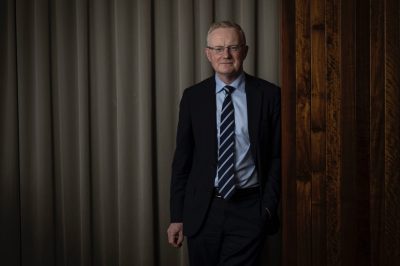Don’t blame us’: RBA governor defends painful rapid rate hikes, downplays role in property boom
Reserve Bank of Australia governor Philip Lowe maintains the central bank “did the right thing” during the “scary” days of the pandemic when it predicted interest rates wouldn’t rise before 2024.
During his appearance at a federal parliamentary hearing on Friday, Mr Lowe also insisted the RBA isn’t to blame for housing prices and rising rents.

The remarks come as the RBA remains under fire over the flawed rate hike expectations – rates in fact started rising much earlier – and Mr Lowe has again denied ever promising rates would stay on hold until 2024.
“I am frequently reminded that many people interpreted our previous communication as a promise, or a commitment, that interest rates wouldn’t rise until 2024,” Mr Lowe said.
“This was despite our statements on interest rates always being conditional on the state of the economy. This conditionality often got lost in the messaging.”
Mr Lowe indicated such explicit statements about the timing of rate moves won’t happen again.
“We will be much less inclined to do that in the future, but I still think it was the right thing to do at that time. Others disagree with that. But I don’t think it’s going to be part of the regular way of operating and our language about the timing will be vaguer.”
But Mr Lowe appeared to concede the RBA may have made a mistake by being so explicit with its guidance about the timing of future interest rate rises “in those dark days of the pandemic”.
“Some people think that was a mistake, and it may well have been,” he said during a twice-yearly appearance before the House of Representatives Standing Committee on Economics.
“But what we were trying to do there was to send a very strong message to the community that the Reserve Bank would do what was necessary to keep the economy as strong as it could be.
“It was scary, it was a difficult time, and we wanted to use every instrument in our toolkit to provide support for the country. We wanted to provide insurance against the possibility of a very bad outcome.”
Many homebuyers expected rates to remain on hold until 2024 based on the guidance from the RBA until as late as November last year. The central bank has since delivered the fastest rate hikes since 1994, raising the cash rate by 225 basis points since May to 2.35%.

RBA ‘not to blame’ for high home prices and rising rents
While acknowledging interest rates influence the housing price cycle, Mr Lowe said the RBA was not to blame for high housing prices nor for rising rents.
“The fact that Australians have to pay high prices for housing isn’t anything to do with the Reserve Bank over a long period of time,” he said.
“It’s the choices that we’ve made as a society that have given us high housing prices. High housing prices come not from the high cost of construction, they come from the high cost of land embedded in each of our dwellings.”
Mr Lowe said the high cost of land came down to society’s choices about taxation, zoning and urban design, and an under-investment in transport, along with the fact that most people have chosen to live in cities on the coast with a block of land.
“All those things have either reduced the supply of well-located land or increased the demand for well-located land. So we have high land prices embedded which give us high housing prices.”
Mr Lowe said the central bank can’t do anything about that.
“As an individual, not as the central bank governor, I think it would be better if we’d make different choices to give a lower average level of housing prices. That would give people more opportunity and people would need to borrow less.”
Mr Lowe also said higher interest rates are not to blame for higher rents.
“I know interest rates get blamed for lots of things but I don’t think they should be blamed for higher rents for most people. It’s not higher interest rates that are driving higher rents, it’s the tightness in the rental market.”
Mr Lowe said rising rates only had a very marginal effect on rents.
“Some landlords have recently been saying that higher interest rates are going to lead to higher rents because they’ve got a higher cost of financing and they’re going to pass that through to rents in a tight rental market.
“Rents are rising quickly, not because interest rates are going up but the rental market’s tight.”
RBA assistant governor (financial system) Brad Jones said rents as measured in the consumer price index are increasing at about a 2% rate, but households that have to renew their leases are facing a “very material increase” in rent with an annual increase of about 12% in new advertised rents.
“For low-income households, those who rent and those who are facing rent resets, there’s no question that there are a growing number of households that are feeling real strain on their household budgets,” Dr Jones said.
He said RBA analysis showed about a third of home loan borrowers are quite well placed to accommodate an increase in the cost of living and borrowing costs, and won’t have any increase in their actual repayments until the end of next year.
Other households may be able to curtail their discretionary spending or run down the financial buffers they built up during the pandemic, but some would not have any spare cash flow left over, he said.
“About 15% of borrowers are not going to have any spare savings each month if the market path for interest rates and our inflation profile are borne out,” Dr Jones said.
People are ‘hurting’ but alternative ‘hurts more’
Mr Lowe admitted higher interest rates are “hurting” many people, especially those who borrowed large sums recently, at a time when higher petrol prices and grocery bills are squeezing household budgets.
But he argued the alternative of allowing higher inflation to become entrenched would “hurt people more”.
“If you’ve got a mortgage, you don’t like higher interest rates – we understand that – and it hurts. But having inflation higher for a long period of time will mean higher interest rates and fewer jobs, and that will hurt a lot more.”
While he maintained the RBA was “only one voice out there” when individuals make decisions, Mr Lowe conceded many people took heed of the RBA’s advice.
“People did, no doubt, take heed of what we said, and we wanted them to. The community took the message that interest rates were going to stay low for a long period of time.
“Our underlying message was that the Reserve Bank would be standing with the community to do what was necessary to support the economy.”
In the past, about 10% of people taking out a mortgage went for a fixed-rate loan, whereas that number soared to almost 50% during the pandemic.
“People did respond sensibly in taking out fixed-rate loans during that period,” Mr Lowe said.
“They were prepared to go and buy property or undertake other investments because they could get fixed-rate money for three years.”
Mr Lowe acknowledged a lot of people, both those with home loans and the one-third of Australians who rent, are “finding things difficult at the moment”.
“Rents are going up – new rents are going up quite quickly for people – and there are a large number of people who have high debt and low buffers. We know that that is very difficult for people.”
RBA says home price falls of 10% possible
Mr Lowe said he expected home prices to fall further as rates rise and wouldn’t be surprised if they fell by 10%, noting prices would still be above pre-pandemic levels.
“Prices went up 25% over the past two years – a very, very big increase,” he said.
“This is not a forecast but it would not surprise me if prices came down by a cumulative 10%, and even if they did that they’re still up 15% over three years.”
Mr Lowe said he did not want to forecast housing prices, which he noted was difficult.
“But as interest rates rise further – and they will rise further – I’d expect more heat to come out of the housing market and prices to come down further.
“We’ve got to remember prices went up 25% in two years.”
The latest PropTrack Home Price Index showed prices nationally are now down 2.7% from their peak in March, and have retraced all their early 2022 gains to be 1% lower over the year-to-date.
Economists at Australia’s four largest banks are forecasting peak-to-trough home price falls of between 15% and 18% by the end of 2023, although CBA now expects the bottom will be reached mid-next year before prices gradually rise.
Read More >>





